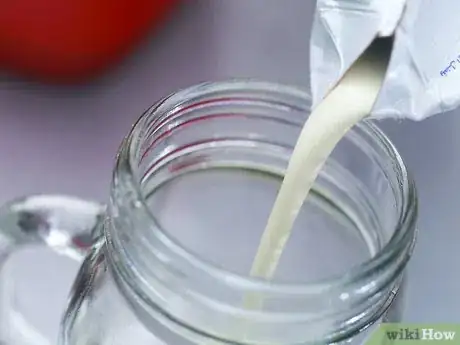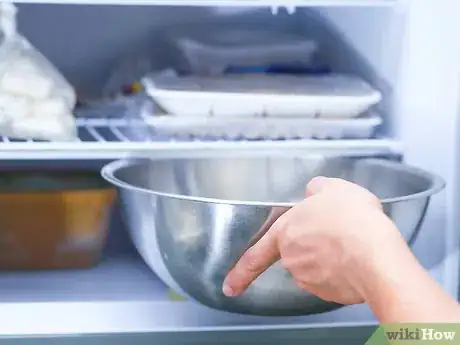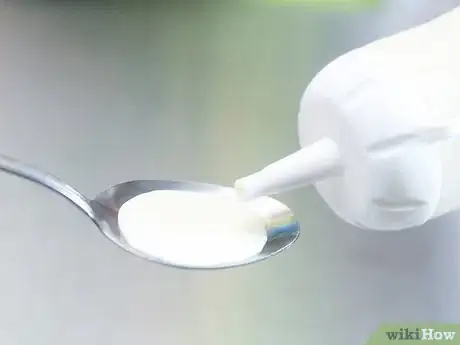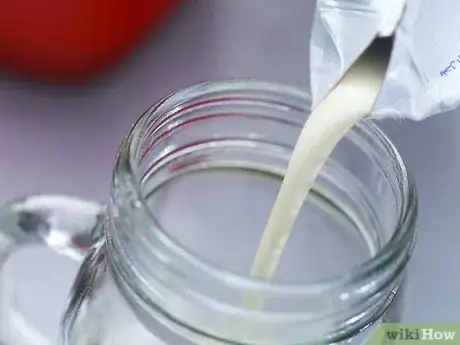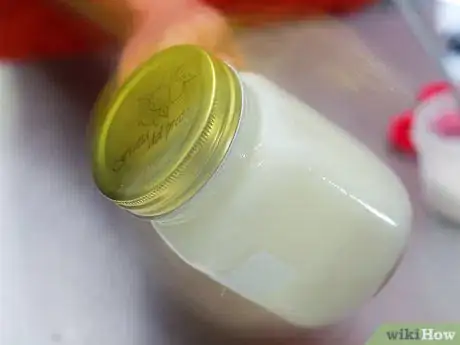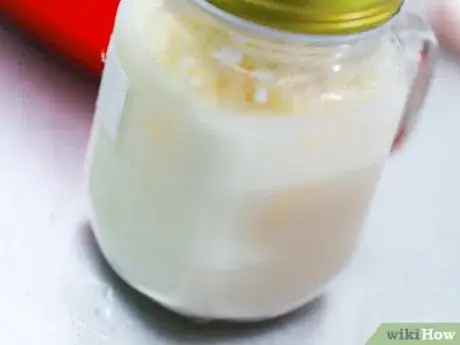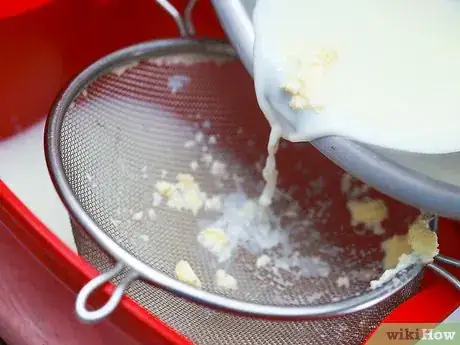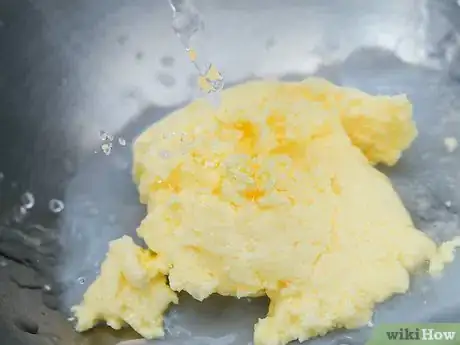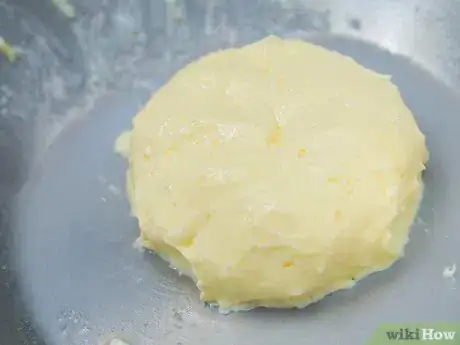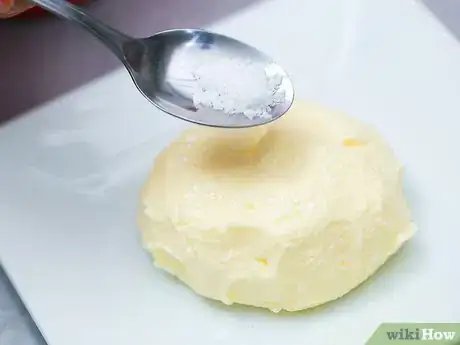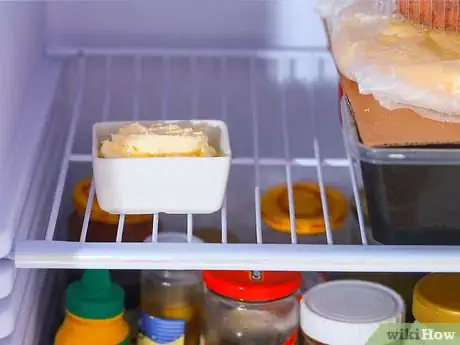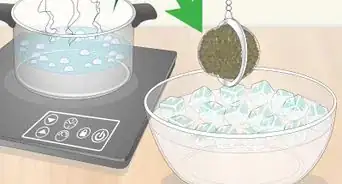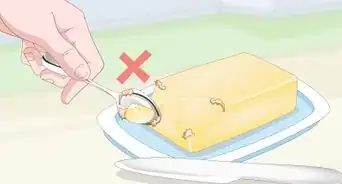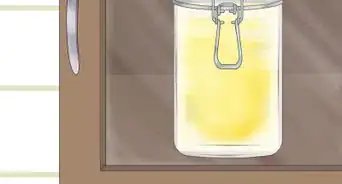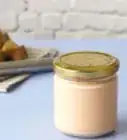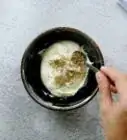This article was co-authored by wikiHow Staff. Our trained team of editors and researchers validate articles for accuracy and comprehensiveness. wikiHow's Content Management Team carefully monitors the work from our editorial staff to ensure that each article is backed by trusted research and meets our high quality standards.
wikiHow marks an article as reader-approved once it receives enough positive feedback. This article received 11 testimonials and 90% of readers who voted found it helpful, earning it our reader-approved status.
This article has been viewed 670,923 times.
Learn more...
Homemade butter tastes much better than industrially produced store-bought butter, and only takes about 20 minutes of work to make. For a flavor no longer widely available in many regions, add bacterial cultures to make the cream more acidic.
Ingredients
- Heavy cream
- Buttermilk, yogurt, or mesophilic cultures (optional)
- Salt (optional)
- Chopped herbs, garlic, or honey (optional)
Steps
Preparing the Cream
-
1Start with fresh, heavy cream. Heavy whipping cream has the highest fat percentage, making it easier and more productive to turn into butter. For a more unique flavor not available in stores, try buying raw cream from a local dairy. If this is not available, vat-pasteurized cream will produce the best flavor, followed by ordinary pasteurized cream, with ultra-pasteurized (UHT) cream a last choice option.[1] [2]
- Avoid cream that contains added sugar.
- The fat percentage listed on the cream tells you how much of the cream will end up turning into butter. A minimum of 35% is recommended.
- In the US, you can search Real Milk Finder for local sources of raw milk.
-
2If using an electric mixer, chill a large bowl and a container of water. A colder bowl will prevent the butter from melting. Chilling a second container of water may also be useful at this stage, especially if your tap water tends to be on the warm side.Advertisement
-
3Pour the cream into the bowl. Don't fill it to the brim, since the cream will expand with air before it turns into butter.
-
4Add cultures for a stronger flavor and easier churning (optional). If you skip this step, you'll be making sweet cream butter, a mildly flavored variety that includes almost all commercial butter sold in the United States and the United Kingdom.[3] If you want a more complex flavor, similar to butter sold in continental Europe, introduce a slight, acidic fermentation to make "cultured butter" instead. This acid also speeds up the breakdown of fat and liquid, shortening the churning time.
-
5Let cultured cream stand at room temperature. If you added cultures, leave the cream out for between 12 and 72 hours, checking every few hours. The cream is cultured once it is slightly thick, foamy, and smells sour or tangy.[6]
- For sweet cream butter without culturing additives, just leave out the cream until it reaches about 50–60ºF (10–16ºC). This will make it easier to churn, but is still cold enough that the butter should be firm and easy to handle during the later stages.[7]
Turning the Cream into Butter
-
1Churn or shake the cream. If you have a butter churn, churn the handle for approximately 5 to 10 minutes. Churning is very easy and efficient with a well-built butter churn. If you have an electric mixer, use the whisk attachment and start it on low to prevent spatter. Otherwise, seal the cream in a Mason jar and shake it. Mixing typically takes 3 to 10 minutes, while shaking takes roughly 10 to 20 minutes.
- To speed up the shaking method, drop a small, clean, glass marble into the jar before shaking.
- If your mixer only has one speed setting, cover the bowl with plastic wrap to catch spray.
-
2Watch the cream change consistency. The cream will go through several stages as you mix it:[8]
- Frothy or slightly thick cream.
- Soft peaks. Raising the mixer will leave a standing peak with a drooping tip. You can now increase the speed of the mixer.
- Whipped cream, forming stiff peaks.
- The cream will start to look granular, and become very pale yellow. Reduce speed again before liquid appears, to prevent spatter.
- Break down: Finally, the cream will suddenly separate into butter and buttermilk.
-
3Pour the buttermilk into a separate container, and save it for use in other recipes. Continue to mix the butter and pour off more liquid as it appears. Stop churning once the solid looks and tastes like butter, or when almost no more liquid is coming out.
-
4Wash the butter in cold water. If any buttermilk remains with the butter, it will spoil very quickly, so this needs to be done unless you eat the butter within 24 hours.
- Pour ice water or chilled water into the butter.
- Knead it with a clean hand, or use a wooden spoon to press the butter.
- Pour out the ice water through a strainer.
- Repeat until the water is mostly clear. This takes at least three washings, and sometimes several more.
-
5Press out the remaining liquid. Use your hands and the back of the spoon to press any water remaining in the butter. Strain this out of the butter.
-
6Mix in salt or other ingredients (optional). Add sea salt to taste if you prefer salted butter; try ¼ tsp (1.25 mL) per ½ cup (120 mL) butter.[9] Homemade butter is delicious by itself, but you can try all kinds of additions for variety. Consider dried herbs or finely minced garlic. You can even make a sweet spread by mixing in honey until smooth.
- Be aware that the added flavors may taste significantly stronger after freezing and thawing the butter.
-
7Store in the refrigerator or freezer. Homemade butter typically stays good in the fridge for at least a week, and up to three weeks if you thoroughly pressed out all the buttermilk.[10] In the freezer, unsalted butter will stay top-quality for about five or six months, while salted butter can last as long as nine months before taste is affected.[11]
- Unlike many foods, tightly wrapped butter will not suffer in texture when frozen.
Community Q&A
-
QuestionWhat do I do if it won't turn into cheese?
 Community AnswerButter is not supposed to turn into cheese. Making cheese is its own separate process.
Community AnswerButter is not supposed to turn into cheese. Making cheese is its own separate process. -
QuestionCan I use a blender and heavy cream to make butter?
 Community AnswerYes, you can. It takes mere seconds to get a nice glob of butter, but then you have to get the butter off the blender's blades, and that will take a couple of minutes.
Community AnswerYes, you can. It takes mere seconds to get a nice glob of butter, but then you have to get the butter off the blender's blades, and that will take a couple of minutes. -
QuestionWhat do I do if it takes too long to turn into butter?
 Community AnswerIt will take some time. If you churn it for 35 minutes and nothing is happening then you do not have any cream in your liquid.
Community AnswerIt will take some time. If you churn it for 35 minutes and nothing is happening then you do not have any cream in your liquid.
Warnings
- Try to consume homemade butter as quickly as possible, as it won't last as long as commercial butter and can get stale very quickly.⧼thumbs_response⧽
Things You'll Need
- large bowl
- strainer
- rubber spatula or wooden spoon (optional)
- either butter churn (recommended)
- or electric mixer
- or Mason jar
References
- ↑ http://www.cheesemaking.com/Butter.html
- ↑ http://www.theprairiehomestead.com/2013/12/how-to-make-butter.html
- ↑ http://www.cheesemaking.com/Butter.html
- ↑ http://www.cookingforengineers.com/article/113/Making-Butter
- ↑ https://www.thekitchn.com/how-to-make-butter-and-cultured-butter-cooking-lessons-from-the-kitchn-194372
- ↑ https://www.thekitchn.com/how-to-make-butter-and-cultured-butter-cooking-lessons-from-the-kitchn-194372
- ↑ http://www.cheesemaking.com/Butter.html
- ↑ http://www.cookingforengineers.com/article/113/Making-Butter
- ↑ http://www.cookingforengineers.com/article/113/Making-Butter
About This Article
To make homemade butter, first, pour heavy whipping cream into a large chilled bowl. Allow the cream to rest until it is about 50 to 60 °F (10 - 15°C). Then, pour the milk into a large jar and shake it for around 10 minutes, or until it breaks down into butter and buttermilk. Pour off the buttermilk as it forms, and continue shaking the remainder until the solid looks and tastes like butter and no more liquid is coming out. Pour ice water into the butter and pour it out through a strainer to remove any buttermilk. Then, press out the remaining liquid with a spoon and store your butter in the fridge or freezer. For more tips, including how to make churning easier, read on!
